Editing Terms
ESTABLISHING SHOT/REESTABLISHING SHOT
Establishing and reestablishing shots show the spatial relationships between the important figures, objects, and setting in a scene. Usually, the first few shots in a scene are establishing shots. They introduces us to a location and the space relationships inside it.
In the initial sequence from Peking Opera Blues (Do Ma Daan, Honk Kong,1986), director Tsui Hark uses three shots to establish the locale. In the first one, three musicians are shown against a fireplace in what looks like a luxurious room. Our suspicions are confirmed by the second establishing shot, which shows us the other half of the ample room (shot/ reverse shot) and reveals a party going on.
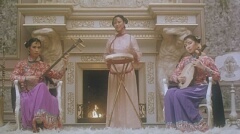
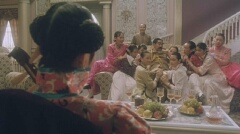
After this introduction, the camera moves forward with several close-ups of both the musicians and the spectators. At the end of the sequence, Hark shows us the entire room in a larger shot. This final establishing shot is called a reestablishing shot, because it shows us once again the spatial relationships introduced with the establishing shots.
SHOT/REVERSE SHOT
A editing techinque in which one character is shown looking at another character (who's sometimes off camera), and then the other character is shown looking back at the first character. This is perhaps the most fundamental editing technique of continuity style. The best way to get a feel for it is to look at the Ramos and Zhou short film about it:
CROSS CUTTING/ PARALLEL EDITING
A second fundamental technique of continuity style is cross cutting or parallel editing. This technique alternates shots from two different sequences of action, and by so doing, associates them. Cross cutting technique is most frequently used to show two or more story elements that are happening at the same time. However, that doesn't have to be the case. It can also be used to associate things that happen at different times. Here are two examples. The first is a classic (and very bloody) scene from The Godfather (1972) in which cross-cutting is used to associate Michael Corleone at a baptism with a series of brutal murders that are happening at the same time.
EYELINE MATCH
Another basic element of continuity style. Based on the premise that viewers will what to see what a character is looking at, the eyeline match is a transition that shows the trajectory of the looking eye; not just what a character is looking at but also the angle from which they're seeing it. Eyeline matches can cut to anything, but frequently what a character is seeing is other characters. There's a great example of an eyeline match at second 24 of this clip from Now Voyager (1942).
And here's a nice little quick video that shows 5 examples of eyeline matches:
MATCH ON ACTION
Match on Action is a continuity editing technique that connects two different shots of the same action at the same moment in the movement. By carefully matching the movement across the two shots, filmmakers make it seem that the motion continues uninterrupted. Generally, the action begins in the first shot and ends in the second. Here's a great example from Buster Keaton Neighbors (1920).
180 DEGREE RULE
Another critical continuity element states that the camera can only move through the 180 degree arc on one side of a line of an imaginary line between the characters you're showing. The best way to understand this is to look at the following short video:
CUT IN CUT AWAY
An instantaneous shift from a distant framing to a closer view of some portion of the same space and vice versa. Cut aways are also band-aids in that they are easy ways to fix a cut that doesn't work. Lots of cut aways are filmed because they give the director and editor lots of options. Here's first an example of a cut in, then an example of a cut away:
DISSOLVE
A dissolve is a transition between two shots during which the first image gradually disappears while the second image gradually appears. For a moment, the two images blend in superimposition. It's a common way to link scenes but can also be used to suggest psychological states or connections between things. Here's a classic (and self-referential) example from Spaceballs (1987):
CHEAT CUT
A cheat cut seems to show continuity in time and space but actually mismatches the positions of figures or objects. A famous example occurs in Meet Me in St. Louis (1944). Look at this shot which shows the position of the telephone on the wall with respect to the family dining:
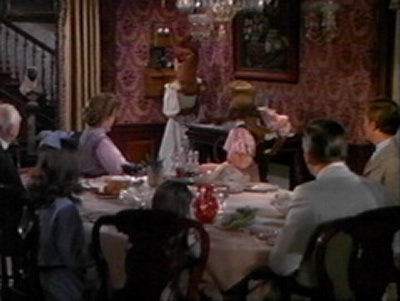
Now look at this second and third shot. You'll see that these shots could not have been taken in the set above... at least not without taking parts of the set apart. In both of these cases, there's a wall in the way. In the film, the movement appears logical and continuous, but if you analyze the scene, you see that it's impossible.
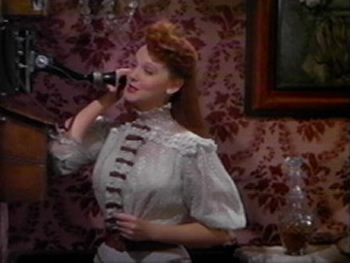
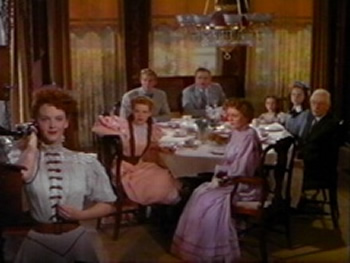
JUMP CUT
A jump cut is a editing technique in which sequential shots of the same subject are taken from more-or-less the same camera position. Jump cuts were made famous by French New Wave directors. They serve a variety of purposes including giving the film an authentic feel, reminding the viewer that they are watching a film (thus a jump-cut can be an anti-continuity device) and jumping forward in time. Here's a use of jump shots to indicate the passage of time. This one is from Little Shop of Horrors (1986):
Return to Continuity Style Page